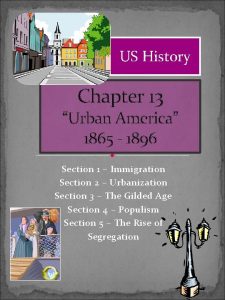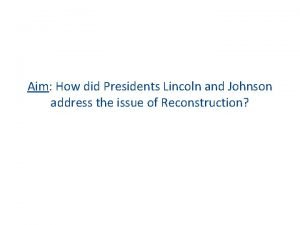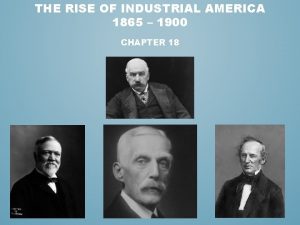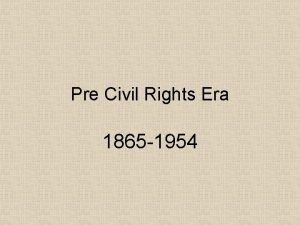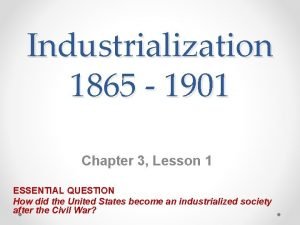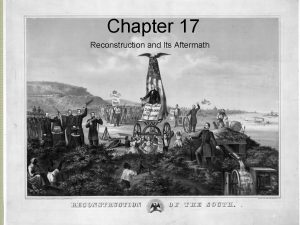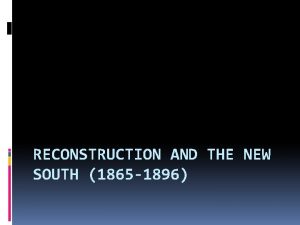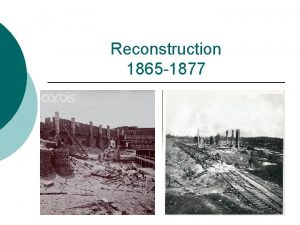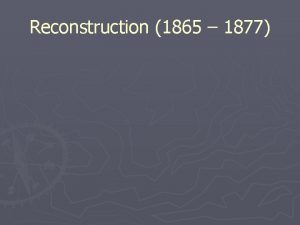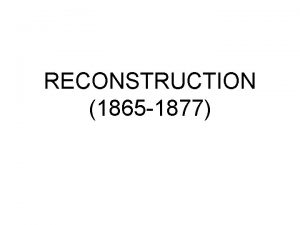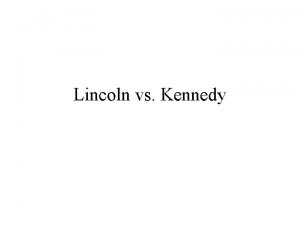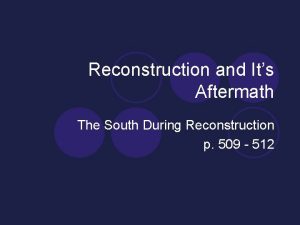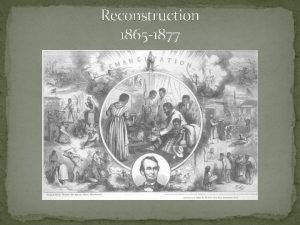Reconstruction and its aftermath 1865 1896 Reconstruction Lincoln















- Slides: 15

Reconstruction and its aftermath 1865 -1896

Reconstruction: Lincoln Style • The Civil War saved the Union but shook the nation to its roots. It left the South with enormous problems. • The period of rebuilding after the war is called Reconstruction. • Lincoln offered the first plan for accepting the Southern states back into the Union. In his Ten Percent Plan: • 10% of voters had to take an oath of loyalty to the Union • States needed to write new constitutions banning slavery • Lincoln argued that punishing the South would serve no useful purpose and would only delay healing the nation.

Radical Republicans • The “Radical Republicans” in the U. S. Congress led by Thaddeus Stevens of Pennsylvania, found Lincoln’s plan too mild. They wanted to punish the South. • • The federal government created the Freedmen’s Bureau to help former slaves. They distributed food and clothing and provided medical assistance. • The Freedmen’s Bureau’s greatest success was in the area of education. They created many new schools and colleges for African Americans.

Lincoln Assassinated • On April 14, 1865, Abraham Lincoln went to Ford’s Theater to watch a play. • He was shot in the back of the head by John Wilkes Booth. He died the next day. • Booth was part of a larger conspiracy made up of Confederate sympathizers. • Secretary of State William Seward was stabbed but recovered. Another man was supposed to shoot vice-president Andrew Johnson, but he failed. • Booth was later trapped in a barn and killed. The others involved were hung in public.

A new President-the th 13 Amendment • Andrew Johnson became president after Lincoln’s assassination. He was a Democratic senator from Tennessee. • His reconstruction plan was called “Restoration. ” • Johnson offered no equal or voting rights for African Americans. • Before they could reenter the Union, Southern states had to 1. 2. Create a new state constitution banning slavery Ratify the 13 th Amendment • The 13 th Amendment abolished slavery in all parts of the United States. • Northerners felt that Johnson’s plan was too easy. They also argued that treatment of African Americans in the South was not improving.

Black Codes • In 1865 and early 1866 new state legislatures passed Black Codes in order to control freed men and women and exploit African American workers. • Some black codes were: • Unemployed African Americans could be arrested and fined. • African Americans were banned from owning or renting farms • Black Codes reestablished slavery in disguise.

Civil Rights for th All-14 Amendment • The Civil Rights Act of 1866 granted citizenship to all African Americans. It • Overturned black codes • Went against the Dred Scott decision • President Johnson vetoed this act. But Congress had enough votes to override his veto. • Congress then passed the 14 th Amendment, which granted full citizenship and equal protection to all people born in the United States. (Did not apply to Native Americans. ) • States had to ratify the 14 th Amendment to rejoin the Union. • Out of 11 Southern states, only Tennessee ratified the amendment.

Johnson vs. Congress • In 1867, Congress passed the First Reconstruction Act -divided the south into military districts -gave black men the right to vote -prohibited former Confederate officers from public office • This was followed by the Second Reconstruction Act which required military leaders to register voters. • Johnson then fired his Secretary of War because of political differences. • An outraged Congress voted to impeach the president (charge with wrongdoing). • President Johnson was found not guilty by only one vote (Kansas) and allowed to serve out the remainder of his term as president.

The th 15 Amendment • In 1868 the Republican party abandoned Andrew Johnson. They chose Ulysses S. Grant instead. • Grant won the election of 1868 easily. • After Grant’s election, Congress passed its last piece of Reconstruction legislature. • The 15 th Amendment was ratified in February of 1870, giving African American males the right to vote. • Despite the hardships, there were two African. Americans that were elected to the U. S Senate: • Hiram Revels and Blanch K. Bruce, both from Mississippi.

The Ku Klux Klan • Some Southerners supported Reconstruction. They were referred to as scalawags, meaning “scoundrel” or “worthless rascal. ” • Northern whites who moved to the South during Reconstruction were called carpetbaggers. • Many thought carpetbaggers were taking advantage of the situation in the South. • Violence against African Americans became common. The Ku Klux Klan (KKK) was the most violent of the secret societies. • They kept African Americans from exercising their rights by burning homes, churches, and schools as well as killing African Americans.

Education and Land • Despite violence, many important changes occurred during Reconstruction, especially regarding education. • Within a few years, 50% of Southern whites and 40% of Southern African Americans were enrolled in public schools. • Most of these schools were segregated. • A rumor started that African Americans would receive 40 acres of land a mule. However, freed slaves never received land. • Most freedmen were forced to go into sharecropping. They rented land, seeds, and tools from white landowners. • This led to a cycle of poverty they could not get out of. Sharecropping was not much better than slavery.

I Declare Reconstruction Over! • Northerners began to lose interest in Reconstruction. They wanted the South to solve their own problems. • Southern Democrats used violence to keep African Americans from voting. • In the election of 1876, Rutherford B. Hayes was elected president only after a compromise was reached. • In the Compromise of 1877: 1. The North would withdraw all troops from the South 2. Democrats in the South promised to protect African Americans’ rights • In his inaugural address in 1877, Rutherford B. Hayes declared that Reconstruction was now over.

Who Gets to Vote? • Many Southerners hated Republicans because of Reconstruction. • While the 15 th Amendment said people could not be kept from voting because of their race, Southerners found ways around this law. 1. Poll Tax: A tax must be paid to vote (most African Americans could not afford to pay this tax) 2. Literacy Test: A reading test of the Constitution must be passed to vote (most African Americans could not read) 3. Grandfather Clause: If a person’s father or grandfather voted before Reconstruction, they could vote. (African Americans did not have the right to vote before 1870. )

Separate But Equal • Jim Crow laws kept African Americans separate from whites in most every public place. • In 1896 the Supreme Court ruled in Plessy vs. Ferguson that segregation was legal as long as African Americans had access to public facilities equal to those of whites. • The problem was, the facilities were never equal. • Plessy vs. Ferguson allowed for “separate but equal” for more than fifty years. • The violence against African Americans increased. Mobs lynched African Americans often just because they didn’t behave the right way.

Reconstruction: A Review • Reconstruction was both a success and a failure. • It was a success because: – It helped the South begin to rebuild its economy – African Americans gained greater equality • It was a failure because: – The South was still a very poor rural economy – It didn’t keep the promise of true freedom for African Americans • The Three Reconstruction Amendments-Review • 13 th Amendment (1865): Ended slavery forever in the entire U. S. • 14 the Amendment (1868): declared all people born in the U. S. citizens with full and equal protection of the law • 15 th Amendment (1870): right to vote cannot be denied because of race; gave all black males the right to vote
 Reconstruction and its aftermath
Reconstruction and its aftermath Urban america 1865 to 1896
Urban america 1865 to 1896 World war ii and its aftermath section 1 quiz
World war ii and its aftermath section 1 quiz Lincoln wife
Lincoln wife Lincoln's reconstruction plan
Lincoln's reconstruction plan Dysfunctional conflict
Dysfunctional conflict Beslan school siege aftermath
Beslan school siege aftermath A drunken ride a tragic aftermath answers
A drunken ride a tragic aftermath answers Aftermath diay
Aftermath diay Reconstruction and its effects chapter 4 section 4
Reconstruction and its effects chapter 4 section 4 Chapter 12 reconstruction and its effects
Chapter 12 reconstruction and its effects St helen’s smelting co v tipping (1865)
St helen’s smelting co v tipping (1865) The rise of industrial america 1865-1900
The rise of industrial america 1865-1900 Four features of industrial manufacturing (1865-1900)
Four features of industrial manufacturing (1865-1900) 1954-1865
1954-1865 Industrialization (1865 to 1901 worksheet answers key)
Industrialization (1865 to 1901 worksheet answers key)

